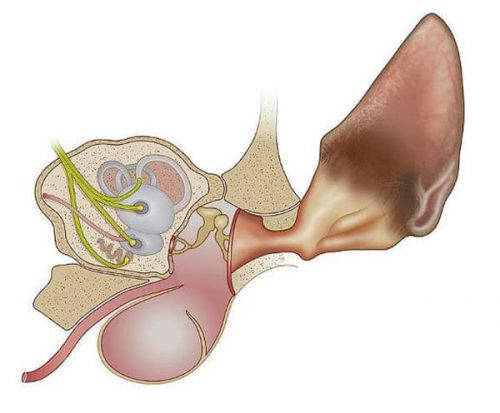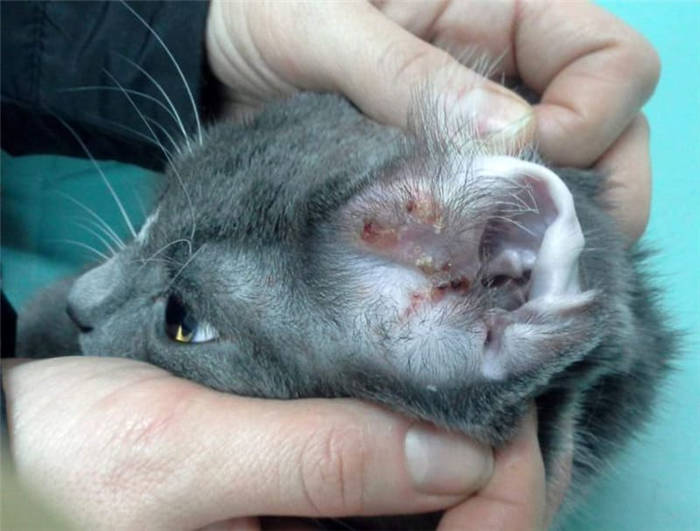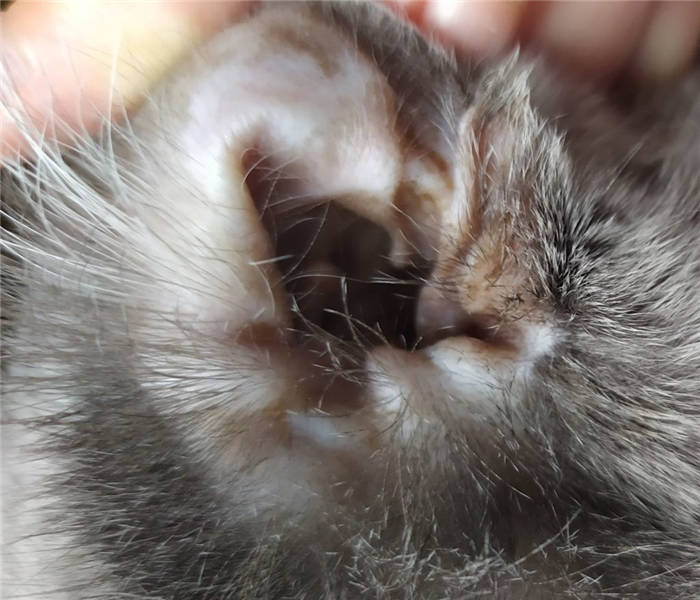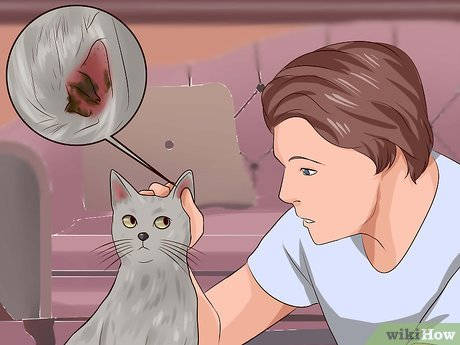Timely prevention of cat ear mites comes down to regular anti-mite treatments and keeping your home clean.

Blog
Among cat owners, ear mite care is a subject of debate. According to some, the pet is perfectly capable of caring for its ears on its own, while others perform ear cleaning several times a week. A healthy pet only needs to be inspected periodically and wiped monthly with lotion. This article will tell you how to clean the cat's ears from dirt, to treat against mite at home with photos and descriptions.
- External, consisting of a fur-covered, funnel-shaped shell with hairs inside and the ear canal;
- The middle one contains the eardrum and the bony cavity with three bones, which are important for the perception of noise;
- The internal part is the most complex part, where the vestibular apparatus, sound receptors are located.
In animals, the ear canal, unlike the short human one, is curved and forms an angle. Improper cleaning can lead to a wax plug and blockage of the ear canal.
Cats can hear sound vibrations in the range of 20-100,000 Hz. Muscles and cartilage are able to rotate the shell to pinpoint the source of the sound vibrations while hunting.

Why animals scratch their ears
Ear scratching is a common hygienic procedure for pets to brush away dirt and particles. It is normal to scratch several times a day.
- When a pet is constantly scratching, shaking (shaking) its head violently, trying to free itself from an invisible object, pawing at its ear.
- Restlessness, aggressiveness, irritability pet.
- Growling, hissing, meowing or other scratching noises.
- Wounds, sores, scratching behind the ears (near) and inside.
Such actions may be caused by domestic or pathological causes.
Domestic is determined by the host, goes away on its own and does not require the intervention of a doctor. These include:
There may be instances where the pet has had an ear laceration. So before you sound the alarm and take your cat to the vet, it's best to make sure there really is a problem.
Pathological causes are dangerous to health. A pet needs medical attention if the cause of scratching is:


Symptoms of otodectosis.
To determine whether the pet has been infected with the parasite, it is necessary to conduct a full diagnosis of its behavior and condition in general.
- Restlessness. Due to the incessant itching, the cat may begin to behave aggressively.
- Scabies. The animal is trying to relieve the discomfort. It will rub against hard surfaces, shake its head, or scratch its ear with its paw. The danger is that scratches will form on the inside of the ear drum as a result. Subsequently, they become infected and begin to fester. This should not be allowed, because it can lead to the death of the pet.
- Swelling. Associated with a large accumulation of blood in the areas affected by the mite.
- Exudate – liquid secretions on the damaged areas. Subsequently, mixed with particles of the epidermis and products of the insect, they are transformed into a brown scab. It is often accompanied by otitis media.
- Lethargy of the animal, associated with an increase in body temperature.
- Crusting in the area of the ear canal, resulting in the formation of plugs of dried sulfur.
- The hair glued from the pus.
- Specific unpleasant odor that can spread to the affected area.
- Hearing impairment in the later stages.
- "Crooked-headedness." The cat constantly turns its head 120 degrees so that the sore ear is located at the bottom.
Important: If you find that your pet has periodic nervous seizures, contact a specialist immediately. In this case, there is a high probability of penetration of the pathogen into the inner ear and the beginning of the process of inflammation of the meninges.
How to treat ear mite in cats: effective drugs
There are quite a few effective preparations for the treatment of ear mite in cats, among which there are both purchased drugs and folk remedies.
Injections
A radical method of eliminating the problem, which only a veterinarian has the right to prescribe. Injection drugs have a high degree of toxicity. They can provoke side effects, such as allergies, itching, hair loss. The advantage of such a procedure is the extermination of all kinds of parasites on the skin of the pet. For example, Doramectin (Dektomax, Doramek), Otodectin are used.
Ointments
- Amidel-gel. Not suitable for treating the inflamed area in animals in the recovery stage, kittens under 2 months of age. The composition includes: acaricide, analgesic, antimicrobial component, wound healing agents.
- Aversectin ointment. It is not recommended to treat the auricles of animals with individual intolerance to the active ingredient – Aversectin, kittens, pregnant and lactating, convalescing "patients". Requires additional use of Perhydrol or specialized lotions to remove "crusts" from the ear.
- Ivermec-gel. Contraindicated for breeds sensitive to the active ingredient, as well as convalescing and emaciated members of the feline family. Contains an analgesic – Lidocaine hydrochloride. Additionally has a wound-healing effect.
To achieve results, clean the pet's ears, apply the drug to the affected area, fold the auricle in two and make a light massage.
Carefully: when using medications for internal use (drops), you should exactly follow the dosage specified in the instructions. Otherwise, the poisons, having accumulated, will poison not only the parasites, but also the animal itself.
Drops .
One of the most effective and simple methods of fighting the mite is the use of drops. Their range is characterized by a fairly wide range of drugs, which allows you to pick the most suitable for both the kitten and the "mommy" in the lactation period.
How long does an ear mite live
The complete life cycle of a mite – from egg to adult – lasts about 30 days: this is enough for the male to fertilize the female, and she lays eggs. One female lays up to 10 eggs per day. Larvae take up to 4 days to develop and up to 9-12 days (sometimes more) to become adults. That's why the parasite colonies multiply so quickly, and the disease progresses rapidly.
In environmental conditions – for example, on a shoe mat or a food bowl – mites live for up to 12 days (sometimes more). This increases the likelihood of getting the disease again, so the treatment of otodectosis has to be taken in several stages.
Please note: statistically, there are more cases of ear mites in cats. However, the parasite can live in the ears of a dog or ferret. These animals are just as carriers. Especially, the breed Yorkshire terrier and other species whose ears are down, the ear canal is covered or hair grows out of it.
What are the dangers of otodectosis

Otodectosis or ear scabies is an inflammation of the skin of the ear canal caused by an ear mite infestation in cats.
It is almost impossible to track the beginning of the disease in a cat without a magnifying device: adult mites grow to 0.2-0.8 mm, so they remain unnoticed during cursory visual examination. To diagnose otodectosis, you need to go to the veterinary clinic, take a scraping of the ear canal discharge and wait for the results of the examination under a microscope.
Further development of the disease is fraught with the addition of an allergic reaction and insemination of discharges from the ear with secondary microflora. For example, staphylococcus, fungi, or other flora. In an attempt to clean the ears on its own, the cat injures the skin with its claws. Inflammation, eczema and dermatitis develop where the scratches occur.
As a result, prolonged illness can lead to fever, ruptured eardrums and otitis media in the middle ear of the cat. Which, in turn, leads to hearing loss, inflammation of the membrane of the brain and death.
How to rid your cat of ear mites
wikiHow operates on a wiki basis, which means that many of our articles are written by more than one author. This article was edited and improved by 23 people, including an anonymous contributor(s).
The number of sources used in this article is 13. You will find a list of them at the bottom of the page.
Ear mites are microscopic spider-like insects that live on the skin or in the ear canals of cats. [1] X Information source Reaginic hypersensitivity in Otodectes cynotis infestation of cats and mode of mite feeding. Powell et al. Am J Vet Res 41 (877). Ear mites can cause severe ear irritation and itching. Infected cats may constantly scratch their ears, scratching them. The most common complications are skin infections. If you notice similar symptoms in your cat, use the steps below to get rid of ear mites.
Determine if your cat has ear mites

- If your cat is healthy, you will see very little wax in the ears. Ears infected with ticks usually have a black plaque that looks like crushed coffee beans. [3] X Reliable source American Society for the Prevention of Cruelty to Animals Go to source
- The wax serves as a protective coating against possible contamination.
- You may also notice a foul odor coming from the cat's ears.

- The cat can damage the top layer of skin, leading to even more soreness, bleeding, and in some cases, the development of a bacterial infection. [5] X Source of information Small Animal Dermatology. Muller & Kirk. Publisher: Saunders.
- A cat suffering from ear mites for a long time may develop inflammatory polyps in the ear canals, as well as bloody blisters from constant scratching. [6] X Source of information Elaine Wexler-Mitchell, A Healthy Cat., p. 174, (1999), ISBN 1-58245-057-9
- In addition, the outer ear may be inflamed and festering. The cat can also damage its eardrum. In this case, professional medical assistance is required. [7] X Merck/Merial information source, The Merck/Merial Manual for Pet Health, p. 501, (2007), ISBN 978-0-911910-99-5







